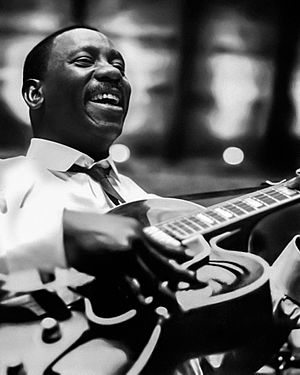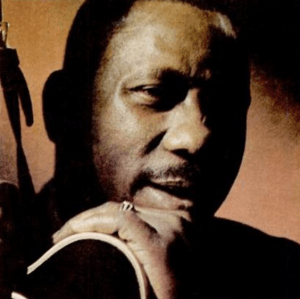Wes Montgomery facts for kids
Quick facts for kids
Wes Montgomery
|
|
|---|---|

Photo of Montgomery during a recording session in the mid-1960s
|
|
| Background information | |
| Birth name | John Leslie Montgomery |
| Born | March 6, 1923 Indianapolis, Indiana, US |
| Died | June 15, 1968 (aged 45) Indianapolis, Indiana |
| Genres | Jazz |
| Occupation(s) | Musician |
| Instruments | Guitar |
| Years active | 1947–1968 |
| Labels | Pacific Jazz, Riverside, Verve, A&M |
John Leslie "Wes" Montgomery (born March 6, 1923 – died June 15, 1968) was a famous American jazz guitarist. Wes was known for his special way of playing the guitar. He used the side of his thumb to pluck the strings instead of a pick. This gave him a unique sound. He also used a lot of "octaves," which means playing the same note at different pitches at the same time.
Wes often played music with his brothers, Buddy and Monk, and with an organ player named Melvin Rhyne. Early in his career, his music was a type of jazz called hard bop and soul jazz. But around 1965, he started making more pop-sounding instrumental albums. These became very popular. His later guitar style influenced new types of jazz like jazz fusion and smooth jazz.
Contents
About Wes Montgomery
Wes Montgomery was born in Indianapolis, Indiana. His nickname "Wes" was a shorter version of his middle name, Leslie. His family was big, and his parents separated when the children were young. Wes and his brothers moved to Columbus, Ohio, with their father.
His older brother, Monk, worked hard to save money. In 1935, he bought Wes a four-string tenor guitar from a pawn shop. Wes spent many hours with this guitar. Later, he said he had to start over when he got his first six-string guitar.
Wes's Music Career
Wes and his brothers moved back to Indianapolis. In 1943, Wes got a job as a welder and got married. One day, he heard a Charlie Christian record at a dance. This music inspired him to buy a six-string guitar the very next day. For almost a year, he practiced day and night. He tried to play just like Charlie Christian.
Wes taught himself to play. He never had formal lessons and couldn't read music. By the time he was twenty, he was playing in clubs in Indianapolis at night. During the day, he worked at a milk company. In 1948, a famous band leader named Lionel Hampton was looking for a guitarist. He heard Wes play and hired him.
Wes played with Hampton's band for two years. He was afraid to fly, so he drove from city to city. Other musicians were amazed at how much energy he had. When he arrived at a club, he always called his wife and family first. He got to play with other great musicians like Charles Mingus. But he was tired and missed his family, so he returned to Indianapolis.
Back home, he played in local clubs. He joined his brothers Buddy and Monk in a band called the Johnson/Montgomery Quintet. This band even played for Quincy Jones. After playing together for a few years, Wes and his brothers went to California.
Buddy and Monk formed a band called The Mastersounds. Wes joined them for a recording session in 1957. Some of these songs were released on albums like The Montgomery Brothers and Five Others. The Mastersounds stayed in California, but Wes went back to Indianapolis. He played with his own trio, including organist Melvin Rhyne.
Wes worked as a welder during the day to support his wife and seven children. Then, he performed at two clubs at night. This was a very busy schedule. One night, famous musicians like Cannonball Adderley and George Shearing were in the audience. Adderley was so impressed that he helped Wes get a record deal with Riverside Records.
In New York City, Wes recorded A Dynamic New Sound, the Wes Montgomery Trio. This was his first album as a band leader. In 1960, he recorded The Incredible Jazz Guitar of Wes Montgomery.
Wes joined his brothers in California to play as the Montgomery Brothers at the Monterey Jazz Festival. He recorded another album as a leader called So Much Guitar. He even got to play with John Coltrane's group in San Francisco.
By 1961, it was harder to find work. After a tour in Canada, his band broke up. Wes returned to Indianapolis to play with his trio again. He recorded a live album in California called Full House. This was followed by Fusion! (1963), which was his first instrumental pop album.
After making two more jazz albums for Riverside Records in 1963, Wes moved to Verve Records. At Verve, he worked with producer Creed Taylor. Wes's first album with Verve, Movin' Wes (1964), was an instrumental pop album. It sold over 100,000 copies very quickly. This made Wes a "crossover artist" who could sell many records to a wider audience.
At Verve, Wes released his last two small-group jazz albums. But his main goal was to record popular pop songs as instrumentals. Wes had big hits with his versions of "California Dreamin'", "Tequila", and "Goin' Out of My Head". Later, he moved to A&M Records and had his biggest radio hit, a version of "Windy". Most of the albums Wes made with Creed Taylor were for the pop market. The success of these albums led to Wes performing on major TV shows like The Tonight Show Starring Johnny Carson.
Wes's Passing
Wes Montgomery died from a heart attack on June 15, 1968. He was at home in Indianapolis and was 45 years old.
How Wes Played Guitar
Jazz guitar teachers say that Wes often played his solos in three parts. He would start with single notes, like playing a melody. Then, he would play octaves for a while. Finally, he would finish with full chords. He used many different chord shapes and arpeggios (broken chords) to create his unique sound.
Instead of using a guitar pick, Wes used the fleshy part of his thumb. He would use down strokes for single notes. For chords and octaves, he used both up and down strokes. He developed this special way of playing not for technical reasons, but for his neighbors! Before he became a full-time musician, he worked long hours as a machinist. He practiced late at night. To keep his neighbors from complaining, he played quietly by using his thumb.
Awards and Honors
Wes Montgomery received many awards and honors for his amazing talent:
- Second Place, Readers' Poll, Metronome, 1960
- Most Promising Jazz Instrumentalist, Billboard, 1960
- Talent Deserving Wider Recognition, DownBeat, 1960
- Readers' Poll and Critics' Poll, DownBeat, 1961
- Readers' Poll and Critics' Poll, DownBeat, 1962
- Best jazz guitarist, DownBeat magazine Critics' Poll, 1960–63, 1966, 1967
- Grammy Award, Best Instrumental Jazz Performance, Goin' Out of My Head, 1966
- Jazz Man of the Year, Record World, 1967
- Grammy Award, "Eleanor Rigby" and "Down Here on the Ground", 1968
Praise for Wes Montgomery
Many musicians have honored Wes Montgomery:
- Stevie Wonder wrote two songs about Wes: "Bye Bye World" and "We All Remember Wes."
- In 1982, Bob James and Earl Klugh recorded a song called "Wes" as a tribute.
- Guitarist Emily Remler released an album called East to Wes in 1988, honoring him.
- Pat Martino released Remember: A Tribute to Wes Montgomery in 2006.
- Eric Johnson paid tribute to Wes on his 1990 album Ah Via Musicom with a song called "East Wes."
- Jazz guitarist Bobby Broom said that Wes "introduced a brand new approach to playing the guitar."
- Lee Ritenour recorded a tribute album in 1993, Wes Bound, playing in Wes's style.
Discography
Albums as a Leader
During his lifetime
|
With Buddy and Monk Montgomery
|
See also
 In Spanish: Wes Montgomery para niños
In Spanish: Wes Montgomery para niños




